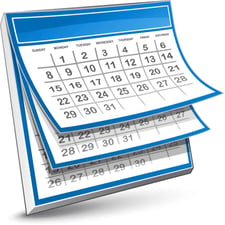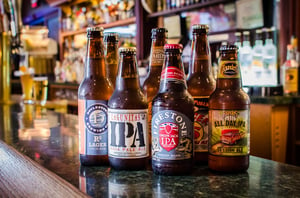In Part 1 of this post, we discussed some of the problems associated with calculating liquor cost. In this section, we will provide you with some tips to help you eliminate these problems.
If you experience a bouncing liquor cost, it is a clear sign that one or more problems were encountered in calculating your liquor cost. There are several steps you can take to troubleshoot and eliminate these problems associated with calculating liquor cost.
Check Your Dates
 A common problem we see among our bars involves keeping the dates of deliveries straight. It is important to use only deliveries that were received by the night before the day you count your inventory and calculate your liquor cost. This will ensure you get a precise count of what has been brought in during the time period being evaluated. All deliveries made on the day you calculate liquor cost should be included in your next time period.
A common problem we see among our bars involves keeping the dates of deliveries straight. It is important to use only deliveries that were received by the night before the day you count your inventory and calculate your liquor cost. This will ensure you get a precise count of what has been brought in during the time period being evaluated. All deliveries made on the day you calculate liquor cost should be included in your next time period.
Follow the same process when selecting dates to be evaluated in your POS system.
Exclude Delivery Charges and Keg Deposits
Liquor invoices have charges for actual products, delivery fees, and refundable keg deposits (for beer). Since you are only trying to calculate the cost of the product, delivery fees and keg deposits must be excluded.
Split Liquor Cost by Category
It is important to split liquor cost into separate categories for draft beer, bottled beer, liquor, wine, and miscellaneous. This will increase accuracy when you are calculating your liquor cost. If you lump all of these figures into one category, it is much harder to identify errors or jumping trends.
 Some bars will combine draft beer and bottled beer totals into one category. Bar-i strongly recommends against doing this. Typically, draft beer costs are about 8% lower than bottled beer costs. If you blend these categories, it becomes much messier to calculate the cost of your beer products.
Some bars will combine draft beer and bottled beer totals into one category. Bar-i strongly recommends against doing this. Typically, draft beer costs are about 8% lower than bottled beer costs. If you blend these categories, it becomes much messier to calculate the cost of your beer products.
For example, if you experience a higher volume of bottled beer sales in a particular period, you might notice a higher cost by assessing these categories together. Keeping these figures separate would make it easier to identify the fact that you experienced a shift in sales, not an increase in cost.
Start Early and Complete in One Day
No one likes doing liquor inventory and calculating liquor cost accurately is more challenging than you might think. However, it is still an important task which must be taken seriously. If you try to count inventory late at night at the end of a shift, you will be tired and more likely to rush through the process in order to get home quicker. This increases the likelihood that you will experience errors in your calculations.
It is much more effective to do inventory in the morning when you are fresh, focused, and free of distractions. Mornings are typically slow for most bars, allowing you to give the task your undivided attention. Make sure the person taking inventory is focused on just this task and doesn’t have other responsibilities to handle at the same time.
Also, it is important to complete the entire liquor inventory process in one day. Otherwise, the calculation of your data will be delayed. If an error occurs, this delay will make it much more difficult to identify and correct the errors since many more deliveries will have occurred and more sales will have been entered into your POS system.
Choose a Set Day of the Week and a Dedicated Counter
 It is important that the same person count inventory every time. If you have multiple people performing this task, you create a situation where different people use different methods. This will make it more difficult to streamline your process and more challenging to identify errors when calculating liquor cost.
It is important that the same person count inventory every time. If you have multiple people performing this task, you create a situation where different people use different methods. This will make it more difficult to streamline your process and more challenging to identify errors when calculating liquor cost.
Bar-i also recommends that you pick a set day of the week to do liquor inventory. This makes the process consistent and ensures the same person will always be available to perform the task. We typically advise our clients to choose Monday since inventory levels are typically lower after a weekend. As a result, there will be less to count.
It is also best to take inventory once a week rather than once a month. When you only perform this task once a month, you are not taking inventory frequently enough to generate accurate data. If for some reason you feel once a week is too often, then taking inventory bi-weekly provides a happy medium.
Prepare in Advance
Counting inventory must be done on a specific day since you are trying to freeze time, but you can still gather other information in advance. Entering invoices into accounting software and pulling a report telling you what was delivered should be done in the before you start counting and calculating liquor cost.
Get Organized and Be Methodical
When inventory changes positions or the same product is stored in multiple locations, you are complicating the task and creating more opportunities for error. Keeping your inventory well organized is one of the best ways to reduce the risk of these errors when calculating liquor cost.
The day before you take inventory, make sure everything is organized properly. All bottles should be arranged and organized in a logical manner, and all boxes should be broken down and thrown out. If you get your bartenders involved in this task, it will go much quicker.
When doing inventory, always count in the same order (top to bottom, left to right, and back to front). If you’re systematic about how you take inventory, you will complete the task faster and reduce errors.
Use Dedicated Software
 If you still do liquor inventory using a clipboard, you are not getting the best results. There are lots of reasonably priced liquor inventory systems available, such as Bar-i’s system, which will provide you with much more detailed and accurate data.
If you still do liquor inventory using a clipboard, you are not getting the best results. There are lots of reasonably priced liquor inventory systems available, such as Bar-i’s system, which will provide you with much more detailed and accurate data.
Bar-i has also recently developed a free downloadable liquor inventory tool that provides you with the following benefits:
- Eliminates data transfer and mistakes – Inventory is counted right into your Excel spreadsheet, eliminating transfer errors
- Mapping – Products can be counted in zones, making the process more organized
- Templates for calculations – Simply enter the raw numbers into the system and all calculations are done for you, reducing your risk of errors
- Compare to your history – The software graphs your liquor cost over time, helping you identify errors and notice trends
By following these tips, you can eliminate many of the errors which cause problems calculating liquor cost.
For additional tips on how to streamline your liquor inventory processes or to schedule a free consultation, please contact Bar-i today or call 303-219-0196. We provide services to bars nationwide from our offices in Denver, Colorado.

